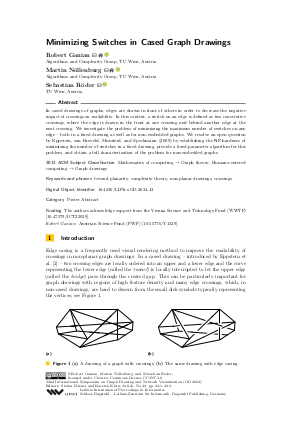Minimizing Switches in Cased Graph Drawings (Poster Abstract)
Authors
Robert Ganian  ,
Martin Nöllenburg
,
Martin Nöllenburg  ,
Sebastian Röder
,
Sebastian Röder 
-
Part of:
Volume:
32nd International Symposium on Graph Drawing and Network Visualization (GD 2024)
Part of: Series: Leibniz International Proceedings in Informatics (LIPIcs)
Part of: Conference: Graph Drawing and Network Visualization (GD) - License:
 Creative Commons Attribution 4.0 International license
Creative Commons Attribution 4.0 International license
- Publication Date: 2024-10-28
File

PDF
LIPIcs.GD.2024.43.pdf
- Filesize: 0.57 MB
- 3 pages
Document Identifiers
Subject Classification
ACM Subject Classification
- Mathematics of computing → Graph theory
- Human-centered computing → Graph drawings
Keywords
- beyond planarity
- complexity theory
- non-planar drawings
- crossings
Metrics
- Access Statistics
-
Total Accesses (updated on a weekly basis)
0PDF Downloads0Metadata Views
Abstract
In cased drawings of graphs, edges are drawn in front of others in order to decrease the negative impact of crossings on readability. In this context, a switch on an edge is defined as two consecutive crossings, where the edge is drawn in the front at one crossing and behind another edge at the next crossing. We investigate the problem of minimizing the maximum number of switches on any edge - both in a fixed drawing as well as for non-embedded graphs. We resolve an open question by Eppstein, van Kreveld, Mumford, and Speckmann (2009) by establishing the NP-hardness of minimizing the number of switches in a fixed drawing, provide a fixed-parameter algorithm for this problem, and obtain a full characterization of the problem for non-embedded graphs.
Cite As Get BibTex
Robert Ganian, Martin Nöllenburg, and Sebastian Röder. Minimizing Switches in Cased Graph Drawings (Poster Abstract). In 32nd International Symposium on Graph Drawing and Network Visualization (GD 2024). Leibniz International Proceedings in Informatics (LIPIcs), Volume 320, pp. 43:1-43:3, Schloss Dagstuhl – Leibniz-Zentrum für Informatik (2024)
https://doi.org/10.4230/LIPIcs.GD.2024.43
BibTex
@InProceedings{ganian_et_al:LIPIcs.GD.2024.43,
author = {Ganian, Robert and N\"{o}llenburg, Martin and R\"{o}der, Sebastian},
title = {{Minimizing Switches in Cased Graph Drawings}},
booktitle = {32nd International Symposium on Graph Drawing and Network Visualization (GD 2024)},
pages = {43:1--43:3},
series = {Leibniz International Proceedings in Informatics (LIPIcs)},
ISBN = {978-3-95977-343-0},
ISSN = {1868-8969},
year = {2024},
volume = {320},
editor = {Felsner, Stefan and Klein, Karsten},
publisher = {Schloss Dagstuhl -- Leibniz-Zentrum f{\"u}r Informatik},
address = {Dagstuhl, Germany},
URL = {https://drops.dagstuhl.de/entities/document/10.4230/LIPIcs.GD.2024.43},
URN = {urn:nbn:de:0030-drops-213271},
doi = {10.4230/LIPIcs.GD.2024.43},
annote = {Keywords: beyond planarity, complexity theory, non-planar drawings, crossings}
}
Author Details
Funding
The authors acknowledge support from the Vienna Science and Technology Fund (WWTF) [10.47379/ICT22029].
- Ganian, Robert: Austrian Science Fund (FWF) [10.55776/Y1329].
References
- Sang Won Bae, Jean-Francois Baffier, Jinhee Chun, Peter Eades, Kord Eickmeyer, Luca Grilli, Seok-Hee Hong, Matias Korman, Fabrizio Montecchiani, Ignaz Rutter, and Csaba D. Tóth. Gap-planar graphs. Theoretical Computer Science, 745:36-52, October 2018. URL: https://doi.org/10.1016/j.tcs.2018.05.029.
- David Eppstein, Marc Van Kreveld, Elena Mumford, and Bettina Speckmann. Edges and switches, tunnels and bridges. Computational Geometry, 42(8):790-802, October 2009. URL: https://doi.org/10.1016/j.comgeo.2008.05.005.
- Anthony Mansfield. Determining the thickness of graphs is NP-hard. Mathematical Proceedings of the Cambridge Philosophical Society, 93(1):9-23, 1983. URL: https://doi.org/10.1017/S030500410006028X.
- Thomas J. Schaefer. The complexity of satisfiability problems. In Theory of Computing (STOC'78), pages 216-226. ACM Press, 1978. URL: https://doi.org/10.1145/800133.804350.
